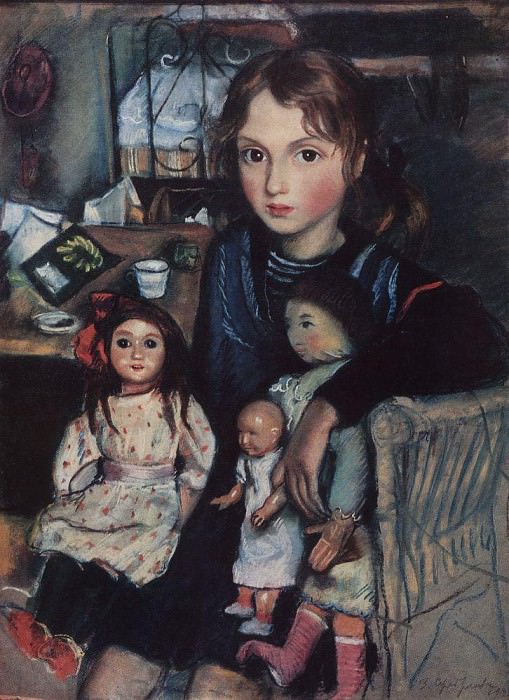Katya with the dolls Zinaida Serebryakova (1884-1967)
Zinaida Serebryakova – Katya with the dolls
Edit attribution
Download full size: 726×1000 px (0,1 Mb)
Painter: Zinaida Serebryakova
The golden fund of Russian art is made up of the works of Zinaida Serebryakova, a talented Russian artist and master of fine painting and drawing. She was a pupil of the famous painter Osip Braz, and became one of the first Russian women to enter the history of painting. Mostly, Serebryakova painted herself and her children. This was due to a lack of money. After her husband’s death, left with four children and a sick mother, the artist moved to Kharkov from Moscow, and then to St.
Description of Zinaida Serebryakova’s painting Katya with Dolls
The golden fund of Russian art is made up of the works of Zinaida Serebryakova, a talented Russian artist and master of fine painting and drawing. She was a pupil of the famous painter Osip Braz, and became one of the first Russian women to enter the history of painting.
Mostly, Serebryakova painted herself and her children. This was due to a lack of money. After her husband’s death, left with four children and a sick mother, the artist moved to Kharkov from Moscow, and then to St. Petersburg.
Serebryakova had four children - two boys and two girls. All of them early began to draw, which could not but please the mother. And subsequently, the passion for art was reflected in the fate of each child. The eldest son, Eugene, became an architect-restorer. He took part in the restoration of architectural monuments of Peterhof, and he also painted several landscapes in watercolor.
His second son, Alexander, arrived in the summer of 1925 in Paris, where Zinaida herself was working. He painted panoramas of the streets with old castles and houses, paintings of landscapes on the beautiful banks of the Seine. Later he became involved in decorating the interiors of the castles of the wealthy French, and was one of the creators of the projects of urban parks in Paris. Here he was a well-known and respected man.
The third child, Tatiana, after graduating from a choreographic school in Leningrad, worked as a theatrical artist in Minsk and Leningrad. After moving to Moscow, she took a job at the Moscow Art Theater, and then to the GITIS. Only at the age of 36 was able to go to visit her mother in Paris.
The youngest daughter, Catherine, became the protagonist of almost all of the artist’s paintings, by which one can trace the girl’s growing up. She began to paint her from her early childhood, during the post-revolutionary period and before emigration. Later, becoming an adult, Katya also became interested in painting and moved to her mother in Paris to help her survive somehow, dedicating herself entirely to it.
Кому понравилось
Пожалуйста, подождите
На эту операцию может потребоваться несколько секунд.
Информация появится в новом окне,
если открытие новых окон не запрещено в настройках вашего браузера.
You need to login
Для работы с коллекциями – пожалуйста, войдите в аккаунт (open in new window).


















You cannot comment Why?
Katya is seated, and it appears she is on some kind of chair or bench with a woven back. She cradles at least three dolls in her arms and lap. The doll closest to the viewer, on her left, is larger and appears older, with dark hair and a patterned dress adorned with a pink ribbon. Next to it, a smaller, bald doll in a white dress stands upright, its arms slightly extended. Behind these, another doll is partially visible, with dark hair and a more traditional doll-like face. The overall composition suggests an intimate and perhaps somewhat somber mood.
The subtexts of this painting could explore themes of childhood, innocence, loneliness, and the transition from childhood to adolescence. The dolls can be interpreted as companions, surrogates for human interaction, or symbols of play and imaginative worlds. Katyas direct gaze and serious expression, coupled with the presence of multiple dolls, might hint at a child who is introspective or perhaps feeling a sense of responsibility or even burden, as if she is playing at being a caregiver. The somber colors and the somewhat cluttered background add to a sense of realism, but also suggest a world that is perhaps more confined or less overtly joyful than typical portrayals of childhood. The painting could be seen as a portrait of a young girl on the cusp of understanding the complexities of the world, using her dolls as a way to navigate her inner thoughts and feelings.